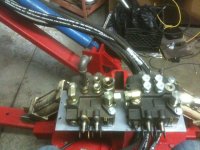Farmerford
Platinum Member
- Joined
- Dec 9, 2006
- Messages
- 733
- Location
- Columbus, Georgia
- Tractor
- Kuborta B2400, L2900, L4330; Caterpillar D3B, John Deere 455D
The rule of thumb is two gallons of tank capacity for every gallon of flow per minute. You said your pump is 11gpm, which would call for a 22 gallon capacity tank; leaving space for air, etc., you would need a 25 gallon physical capacity tank.
But that is big and expensive, and one rarely sees the two to one rule observed in consumer products or light industrial equipment. For instance, I use a 15 gallon capacity tank on an 11gpm pto pump driving a rotary mower; fluid temperatures don't exceed ambient plus 50 F (which is still 150F in mid summer here in southwest Georgia), and I don't have a noticeable aeration problem.
You can affect the temperature with your manner of operating. If you spend a lot of time with the cylinders against the stops and the fluid fllowing through the relief valves you are really heating up the fluid because all the energy produced by the engine is turned into heat. For 1,000 psi drop in pressure you heat the fluid up 7 deg F. So if you have a 2,000psi pump pushing fluid against the relief valve, the fluid temperature rises 14deg F each time it passes through the relief. Your 5 gallon system full of fluid will pass through the relief twice each minute, so the fluid temperarute will go up 28deg F every minute.
I realize that most of us don't just sit there and hold the lever back while the dipperstick stalls against a root for a full minute; but if you become sensitive to just how often in steady, heavy digging you do trigger the relief valve it will surprise you. At least it surprised me.
The design of the tank also matters. A baffle reaches from an inch or so above the bottom to an inch or two from the top does several things. It reduces sloshing of the fluid, the pump intake side is somewhat isolated from the return flow entering on the other side of the baffle, and the fluid from the return flow side gets to the pump side by flowing under the baffle, which means the fluid with fewer air bubbles, which is heavier, gets to the pump first.
So, my guess is that a 10 gallon tank with a baffle and an intake strainer with a 3psi relief valve will probably be okay. A similar 15 gallon tank will almost certainly be okay.
I notice the loop in your suction line in one of the pictures. Straighten out and shorten that line if you can; it won't make a lot of difference, but it will reduce the vacuum at the pump a bit, which never hurts.
Tell us how it works out.
But that is big and expensive, and one rarely sees the two to one rule observed in consumer products or light industrial equipment. For instance, I use a 15 gallon capacity tank on an 11gpm pto pump driving a rotary mower; fluid temperatures don't exceed ambient plus 50 F (which is still 150F in mid summer here in southwest Georgia), and I don't have a noticeable aeration problem.
You can affect the temperature with your manner of operating. If you spend a lot of time with the cylinders against the stops and the fluid fllowing through the relief valves you are really heating up the fluid because all the energy produced by the engine is turned into heat. For 1,000 psi drop in pressure you heat the fluid up 7 deg F. So if you have a 2,000psi pump pushing fluid against the relief valve, the fluid temperature rises 14deg F each time it passes through the relief. Your 5 gallon system full of fluid will pass through the relief twice each minute, so the fluid temperarute will go up 28deg F every minute.
I realize that most of us don't just sit there and hold the lever back while the dipperstick stalls against a root for a full minute; but if you become sensitive to just how often in steady, heavy digging you do trigger the relief valve it will surprise you. At least it surprised me.
The design of the tank also matters. A baffle reaches from an inch or so above the bottom to an inch or two from the top does several things. It reduces sloshing of the fluid, the pump intake side is somewhat isolated from the return flow entering on the other side of the baffle, and the fluid from the return flow side gets to the pump side by flowing under the baffle, which means the fluid with fewer air bubbles, which is heavier, gets to the pump first.
So, my guess is that a 10 gallon tank with a baffle and an intake strainer with a 3psi relief valve will probably be okay. A similar 15 gallon tank will almost certainly be okay.
I notice the loop in your suction line in one of the pictures. Straighten out and shorten that line if you can; it won't make a lot of difference, but it will reduce the vacuum at the pump a bit, which never hurts.
Tell us how it works out.

